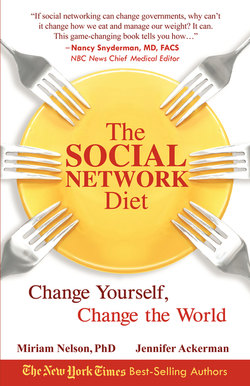Читать книгу The Social Network Diet - Michael Bertoldo - Страница 10
На сайте Литреса книга снята с продажи.
ОглавлениеWHAT DO WE EAT?
We eat more. We’re eating more than we did forty years ago, at least in terms of calories. In the 1970s, young women ate just over 1,600 calories a day; in 2000, consumption jumped to more than 2,000 calories a day. Similarly, midlife women went from 1,510 calories to 1,828 calories, and older women went from 1,325 to 1,596 calories. Most of these extra calories come in the form of added sugars, unhealthy added fats, and refined grains. (The good news is that calorie intake from 2000 to 2008 has remained relatively stable.)
The top five foods sources for calories in the American diet are:
1 Grain-based desserts and snacks (cakes, cookies, doughnuts, pies, crisps, scones, muffins, cobblers, and granola bars)
2 Yeast breads (especially refined white flour breads)
3 Chicken and chicken mixed dishes
4 Soda, energy drinks, and sports drinks
5 Pizza
Grain-based foods in the 1970s added 432 calories per day to our diets; now they contribute an average of 625 calories per day. Similarly, added fats contributed 403 calories per day in 1970 and now add 616 calories per day. Calories from vegetables and fruits have remained steady at approximately 125 and 80 calories per day, respectively.
Lots of SoFAS. The biggest contributors to the increase in calories in our diet come from solid fats and added sugars (known as SoFAS). Solid fats are unhealthy fats such as saturated fat and transfats. Added sugars come from an ever-expanding variety of sources such as high fructose corn syrup and sucrose. These ingredients add calories to food but offer minimal nutritional value. Consumption of these solid fats has risen from 56 pounds per person per year in 1970 to 87 pounds per person in 2008. Added sugars have jumped 15 percent from 119 pounds per person in 1970 to 136 pounds in 2008.
Excessive sugar of any kind appears to affect blood levels of hormones involved in appetite and eating, including insulin, leptin, and ghrelin, and may play a role in the development of diabetes and obesity.
The recommended number of calories from SoFAS should be between 5 and 15 percent of total caloric intake. But today, the average American, young or old, male or female, gets 35 percent or more of their calories from SoFAS. The typical woman 40 years of age is consuming 758 calories a day in SoFAS—from 3.5 tablespoons of solid fat and 23 teaspoons of added sugars per day. One in ten American women is consuming more than 1,000 calories a day in SoFAS, and only 5 percent of women are getting 300 calories a day or less from them.
Where are these calorie-boosting SoFAS coming from?
The top five contributors to added sugars in our food supply are:
1 Sugar-sweetened soda
2 Grain-based desserts and snacks
3 Fruit drinks
4 Dairy-based desserts
5 Candy
The top five contributors to unhealthy solid fats are:
1 Grain-based desserts and snacks
2 Regular cheese
3 Sausage, franks, bacon, and ribs
4 Pizza
5 Fried potatoes (French fries and hash browns)
More refined grains. Refined grains are a big culprit contributing to excess caloric intake. I want to be very clear: We’re not talking about whole grains here. It’s smart to eat whole grains in abundance, because these grains are digested slowly, satisfy hunger for longer periods of time, and provide fiber and other nutrients. However, of the 7.5 ounces of grains consumed per person per day in this country, less than 1 ounce is whole grains. The rest are refined grains, which have a lower fiber content than whole grains and are largely devoid of nutritional value, with the exception of some important vitamins. They also have lower concentrations of the minerals, essential fatty acids, and phytochemicals that are vital to health.
Not all refined grains are equally guilty. For example, plain pasta and white rice are not major contributors to daily caloric intake. But refined grains that act as a vehicle for added sugars and unhealthy fats add huge numbers of calories to our diet. In fact, as you have seen, the single biggest food group that swells our calorie intake is refined grains—cookies, cakes, other dessert foods, and snacks. These grain-based foods are also the top contributor to our intake of solid fats and the number two contributor to added sugars. The past few decades have seen a sharp increase in our intake of these foods. Between 1970 and 2005, total per capita availability of refined grains rose by 41 percent.
More sodium. We also consume too much sodium. Excessive salt contributes to chronic disease, especially hypertension. Sodium intake in the American diet has risen steadily in the past few decades. Now the average American gets 3,436 mg of sodium per day—more than twice what is recommended by the 2010 Dietary Guidelines. Some 5 to 10 percent of this occurs naturally in the foods we eat. Another 10 percent arrives with our use of the salt shaker. This means that the lion’s share of our salt intake—75 to 80 percent—comes from processed foods. The leading contributors to excessive salt consumption include yeast breads, chicken and chicken mixed dishes, pizza, pasta and pasta dishes, lunch meats (cold cuts), condiments, and sausage, franks, and bacon.
Dietary Intakes Compared to Recommended Goals or Limits
